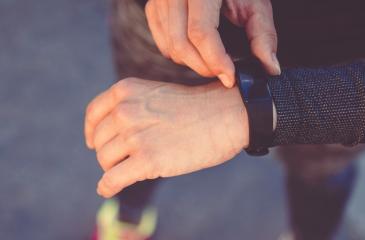Look around in any group setting and you will see them everywhere—smart watches and activity trackers on wrists and waistbands.
As the wearable device industry grows rapidly, research in the broader field of wearable technologies is looming with possibilities. What if these device features and applications could be incorporated and expanded into the clothing we wear each day?
AT THE FOREFRONT OF AN EMERGING FIELD
The University of Minnesota Wearable Technology Lab (WTL) is an interdisciplinary research laboratory focused on the intersection between apparel and new technologies. Founded in 2009 by Lucy Dunne, PhD, and housed in the University’s College of Design, the WTL is a leader in research on the intersection between apparel and new technologies with the potential to keep us healthy, informed and empowered.
Today, the WTL is co-directed by Dunne and Brad Holschuh, PhD. Its research focuses on expanding the functionality of garments to improve the way we use, manage and consume the clothing we wear—and opens up unexplored ways to understand the human body, mind and human capabilities through sensors and interaction. WTL researchers come from diverse backgrounds including aerospace engineering, robotics and fashion design.
With a background in clothing design, computer science and electrical engineering, Dunne’s research explores new functionality in apparel, human-device interface, production and manufacturing, and human factors of wearable products. She received the NASA Silver Achievement Medal for her work with functional clothing and wearable technology. In addition to serving as an Associate Professor in the College of Design, she holds graduate faculty appointments in Electrical Engineering, Computer Science, and Human Factors and Ergonomics.
According to Dunne, one of the biggest limitations to wearable technologies today is limited spatial distribution.
“A smart watch or activity tracker only accesses one area of the body and gives a limited view of what’s happening to the whole person,” said Dunne. “We need more body access to pick up a richer picture of what’s happening to the body, and clothing is a great platform for distributing technology. Much of what we do in the lab is look at how we keep technology comfortable and wearable—something people are willing to wear in their everyday lives.”
An Assistant Professor of Wearable Technology and Apparel Design in the College of Design, Holschuh holds additional graduate faculty appointments in Aerospace Engineering and Mechanics, Human Factors and Ergonomics, and Design. His research encompasses wearable technology, biomedical device development, human factors design, textile engineering, aerospace engineering, bioastronautics and materials science. A self-described soft-roboticist, his interest in clothing as wearable technologies began with his work in the aerospace industry including a partnership with NASA.
“An overarching theme of the lab is thinking about wearable technology as something that could, and should, be part of your clothing,” said Holschuh, “People wear clothing every day, which means it is an appealing platform to host technologies that need regular access to wide areas of the body, so long as the comfort and form factor do not differ significantly from everyday clothing.”
One of the biggest challenges in wearable technology in clothing is designing clothing people will actually want to wear.
“People don’t like to wear things that are heavy and rigid,” said Holschuh. “This is what sets the context for our work in the WTL and what makes our work unique as one of the few entities in the world studying engineering and apparel at the same time – we focus on both the wearable and technology aspects of wearable tech, simultaneously.”
EXPLORING APPLICATIONS FOR HEALTH CARE

Courtesy of Wearable Technology Lab: soft exoskeletons to measure and assist upper-limb mobility
Historically, the health care applications for these technologies have included wearable robotics such as exoskeletons to help people move and support joints. Through a grant from the National Science Foundation, the WTL is studying the potential of unobtrusive, lighter-weight garments to provide upper body tracking and mobility support for children with disabilities.
One area of research with great potential in the health care industry is advanced, dynamic compression garments.

Courtesy of Wearable Technology Lab: shape memory alloy activated compression garments for medical applications
“In their current form, compression garments are really low tech with an almost universal negative user experience,” said Holschuh. “What excites me is something more advanced than the elastic or pneumatic garments that are currently on the market. We are developing dynamically-controllable compression garments where the wearer can modify the tightness in real-time thanks to synthetic muscles embedded in the structure of the garment itself.”
The applications for an improved compression garment range from treatments for those with heart disease, lymphedema, diabetes, autism, sensory processing disorders, orthostatic intolerances and many other diseases and diagnoses where traditional compression garments are typically used.
BRIDGING THE GAP
With a diverse group of graduate students, WTL researchers are bridging the gap between engineering, design and health care.
“We are interested in solving problems and developing technologies for people in real-world situations,” said Dunne. “We are collaboratively chipping away at the problems that will enable the next generation of wearable technologies.”

Courtesy of Wearable Technology Lab: moisture transport in textiles for spaceflight
Studies underway with medical and wellness applications include computer-mediated dynamic compression garments, cut-and-sew e-textile manufacturing, smart garments for mobility support, compression garments for astronaut health, stitched textile sensors and therapeutic biofeedback technologies for musculoskeletal tele-rehabilitation.
“As a soft roboticist and apparel designer, I strive to develop in garments that bend, flex, and stiffen at specific places and times and with minimal form factors – the goal is for these to function as full-fledged robotic systems, built into garments and textiles,” said Holschuh. “We are just beginning to scratch the surface of what’s possible.”



